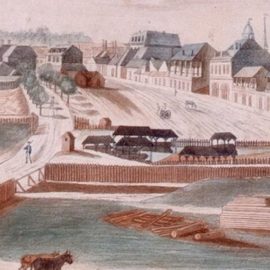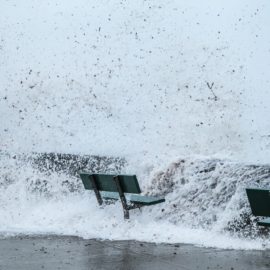
Rain, we have had it and almost a full year of rain and it is only July. Why? Climate change is there, despite those who say it is not, and it shows we need to take actions. The flooding also shows the need for trees, permeable sidewalks and other water anti-retention ideas.
Barry Keim knew the past few months had been unusually wet in southeast Louisiana, but it wasn’t until he looked at the latest data that it really hit him. “Good gracious, look at those numbers!” the Louisiana state climatologist exclaimed Tuesday morning when he pulled up this year’s monthly precipitation totals for New Orleans on his computer. “These are some healthy numbers, man. And we’ve got several more months to go.” It has rained almost every day this month in New Orleans, and another wet week is in the forecast. The city is on pace to hit its annual rainfall average, about 63 inches, in just seven months and to break the record maximum of 102 inches from 1991.The intense, relentless rain is a product of a warming planet. It’s regularly flooding streets, interrupting outdoor construction jobs, stalling lawn work and leaving golf courses devoid of golfers throughout the New Orleans area. More than eight inches of rain fell on the Mandeville area early Tuesday, swamping cars and flooding some houses as it strained the drainage infrastructure. “There’s no system in America, I don’t think, that’s capable of handling that,” Mandeville Mayor Clay Madden said.
nola.com
The rain has not let the ground dry out and with that flooding is more prevalent.
Standing on his porch in Mid-City New Orleans, McKinley Abram, 59, gazed across the small pond spanning the 600 block of South Solomon Street, now a breeding ground for mosquitos. Since March, Abram said, the street has rarely had enough time to dry before more rain arrives. His landlord and neighbors have called on the city officials to add proper drainage in the past, and he said this year’s rainfall has only exacerbated the need. “It’s been like this for some years, and it’s only getting worse; it’s not getting better,” Abram said.
Although we have not had a hurricane or other disturbance, 311 has had more calls than usual.
In New Orleans, calls to City Hall’s 311 number to report street flooding and drainage problems reached a high of 112 complaints in April, the most since June 2020. Calls were concentrated in the St. Claude, Lakeview, St. Roch and Leonidas neighborhoods. Mid-City has seen the most reports of clogged catch basins this year, 93 calls. Though the region has yet to face a tropical weather system this year, heavy rainstorms have been enough to send water as high as the second step of Abram’s elevated house. That moisture lingers under the home, harming the foundation. The house has started to shift, Abram said, and he’s considering moving. “We can’t do nothing about the rain – that’s beyond our reach – but we shouldn’t have the world flooded for days afterward,” he said. “That’s the problem.”
This has been a bit of an unusual year as we started drier than normal and then the tables turned, really turned.
Keim, the climatologist, said 2021 actually started a bit drier than normal but more than made up for the lack of precipitation beginning in the spring.“After March, all hell broke loose,” he said. Lake Charles was hit with 17 inches of rain in just 12 hours, and Baton Rouge has suffered from frequent deluges. “It’s been brutal for a lot of places,” Keim said. Climate change is likely playing a role in the state’s wetter weather. “As temperatures warm, more moisture is stored in the atmosphere,” Keim said. “When you wring that moisture out, you get more water on the ground.”
We are in the tropics and that means we have humidity for longer than most. I do know that even up north there is humidity and as temperatures get higher there will be more of it.
Louisiana’s high humidity plays a key role in its rain patterns, but humidity is usually not enough to produce the almost daily storms that the state has experienced in recent months. It could be that an unusually frequent influx of dry air from the north is triggering the downpours. “As the moist air collides with more dense dry air, the dry air burrows under, causing the air to rise and that gives us rain clouds,” Keim explained.
Because of our location, we also need pumps. Living here that can be a sensitive topic depending on your experiences.
Because about half of New Orleans sits below sea level, the city relies on a vast system of pumps, drainage canals, catch basins and underground pipes – much of it more than a century old – to flush out stormwater. When rain falls faster than the drainage system can remove it, or when the catch basins and canals are clogged, water accumulates, flooding cars, homes and businesses. This year, catch basin cleanings have lagged behind the rate of years past. Unsurprisingly, the neighborhoods with the most street flooding also have high numbers of calls reporting clogged basins. Anytime a storm drops more than 1 inch of water in an hour, it will likely outpace the system’s capability, leading to localized street flooding. “While our staff is trained and prepared for all weather conditions, New Orleans’ drainage system has its limitations,” said Sewerage & Water Board spokeswoman Grace Birch. And as the climate continues to change, more capacity will be needed. “The Sewerage and Water Board of New Orleans has a dedicated workforce doing their best with the equipment and resources we have available,” Birch added, “but as we were able to show President [Joe] Biden and what is reflected in his proposed infrastructure bill is clear: Our utility and many others around the country need modernization, more efficiency and reliability.”
The rain means that we are able to park on the neutral grounds and that permission has been given far more than normal.
So frequently has heavy rain been forecast in New Orleans this year that City Hall has waived neutral ground parking restrictions 23 times this year, including twice this past weekend. The restrictions are lifted to allow residents to park their vehicles on slightly higher ground when severe storms threaten to flood streets. All told, residents have been allowed to move their cars onto sidewalks and neutral grounds for about 770 hours of the year so far – equivalent to more than 32 days. Tuesday’s downpour on Mandeville proved especially ironic. City Hall cancelled what would have been Mandeville’s first meeting around a new resiliency plan to improve water management, said Madden, the mayor. Madden defers to scientists about climate change, but he feels he has seen rainfall increase over his lifetime. In first year as mayor, he saw six hurricanes. “It’s been intense,” he said. Keim said this year might offer a hint at future weather patterns. Rain has been coming in shorter but stronger bursts in recent years, and the trend is likely to continue. “Basically, we’re seeing bigger dumps over shorter periods of time, and that’s wreaking havoc on our urban drainage systems,” Keim said.
The rain is here now and we all know that more is on the way. We need to make changes and while the city has ideas, some groups are working in that field and there is concern, we need to personally work to mitigate this rain and flooding.



